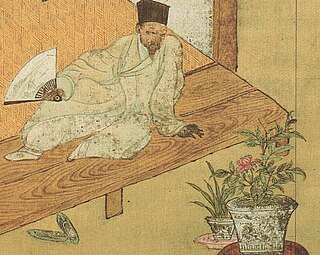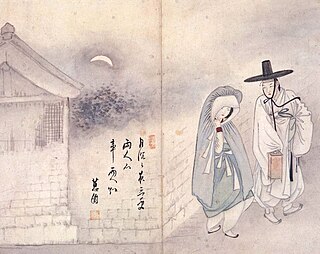 W
WChoe Buk, was a Korean painter of the late Joseon period. He used many pen names, Samgijae, Hosaenggwan, Songjae, Giam, Geogijae among them.
 W
WKang Sehwang (1713–1791) was a high government official but also a representative painter, calligrapher and art critic of the mid Joseon period. He was born in Jinju, Gyeongsangnam-do, the son of Kang Hyeon. He entered royal service at over sixty years old. Kang pursued and established muninhwa with his own creativity. He helped to develop the 'true view' style of painting and was a teacher of Kim Hongdo.
 W
WGim Hong-do, also known as Kim Hong-do, most often styled Danwon (단원), was a full-time painter of the Joseon period of Korea. He was together a pillar of the establishment and a key figure of the new trends of his time, the 'true view painting'. Gim Hong-do was an exceptional artist in every field of traditional painting, even if he is mostly remembered nowadays for his depictions of the everyday life of ordinary people, in a manner analogous to the Dutch Masters.
 W
WJeong Seon (1676–1759) was a Korean landscape painter, also known by the pen name Kyomjae. His cha was Wonbaek and another ho was Nangok. His works include ink and oriental water paintings, such as Inwangjesaekdo (1751), Geumgang jeondo (1734), and Ingokjeongsa (1742), as well as numerous "true-view" landscape paintings on the subject of Korea and the history of its culture. He is counted among the most famous Korean painters. The landscape paintings that he produced reflect most of the geographical features of Korea. His style is realistic rather than abstract.
 W
WShin Yun-bok, better known by his pen name Hyewon (1758–1813), was a Korean painter of the Joseon Dynasty. Like his contemporaries Danwon and Geungjae, he is known for his realistic depictions of daily life in his time. His genre paintings are distinctly more erotic than Danwon's, a fact which contributed to his expulsion from the royal painting institute, Dohwaseo. Painting was frequently a hereditary occupation in the Joseon period, and Hyewon's father and grandfather had both been court painters. Together with Danwon and the later painter Owon, Hyewon is remembered today as one of the "Three Wons" of Joseon-period painting.
 W
WYi Inmun (1745-1821), also known as Yuchun, was a court painter of the late Joseon Dynasty, primarily of landscapes. He also held a military position in the court. Perhaps his best-known work is a silk scroll entitled Gangsan mujindo, which is displayed in the National Museum of Korea in Seoul.
 W
WYi Insang (1710–1760) was a painter and a government officer in the late Joseon period. Yi Insang was born to a high class and grandson of Yi Gyeongyeo who served as Yeonguijeong. He worked as a government officer, Hyeongam of Eumjuk. At 42, Yi retired from the government officer and devoted to painting, poetry and calligraphy.
 W
WYun Du-seo (1668–1715) was a painter and scholar of the Joseon period. He is the grandson of Yun Seondo, a great scholar in Korean history. He passed the gwageo exam, but did not enter government service. Rather, he devoted his whole life to painting and studying Confucianism. His self-portrait is regarded as one of the many masterpieces of Korean art. Yun Du-seo is also known for his yeongmohwa.